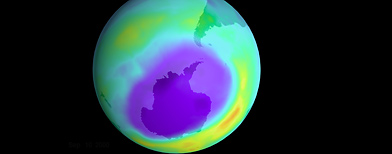Scientific Minds Want To Know

The atmosphere is definitely healing, but the resulting climate change may have an unwanted effect.
Also: Scientists employ the latest imaging techniques to look inside a python that had just swallowed a rat whole. | Scientists discover a common trait in humans and whales that explains why both groups have grandmothers. |
 Dust blown from the Bodélé depression in Chad provides natural fertiliser for the Amazon and the Atlantic
Dust blown from the Bodélé depression in Chad provides natural fertiliser for the Amazon and the Atlantic'Leviathan' ate other whales
A monstrous ancient whale that fed on dolphins, sharks, seals and even other whales has been discovered in Peru.Dubbed the "leviathan", the 17m beast was around the same size as a sperm whale, but was far more aggressive, British journal Nature reported.
The 12-million-year-old leviathan would have been able to feed on prey up to 8m long, according to Paris Natural History Museum director Christian de Muizon.
"It was a kind of a sea monster," he said.
Digging Starts On Buried Stone Circle That Is Ten Times Bigger Than Stonehenge

Archaeologists have begun a major dig to unearth the hidden mysteries of a buried ancient stone circle site that is ten times bigger than Stonehenge. The enormous 4,000 year old Marden Henge, in Wiltshire, is Britain's largest prehistoric structure stretching for 10.5 hectares.
English Heritage is carrying out a six-week dig hoping to reveal the secrets behind the giant henge which has baffled historians for centuries. Most of the Neolithic Marden Henge has been destroyed over the years due to farming and erosion but minor excavations estimate the site to between 2,000 and 2,400BC.
Fossils Push Back Dawn Of Life By 1.5 Billion Years

Up to now, conventional scientific wisdom held that the planet was populated only by single-celled microbes until the so-called Cambrian explosion, a major surge of biodiversity that began some 600 million years ago. Scientists have unveiled fossils from west Africa that push back the dawn of multicellular life on Earth by at least 1.5 billion years.
Just how complex the newly discovered organisms are is sure to be hotly debated. But there can be no doubt that the creatures unearthed from the hills of Gabon, visible to the naked eye, have upended standard evolutionary timelines.
After the Tsunami in 2004 some strange fish washed ashore:
(the video has German titles)


No comments:
Post a Comment